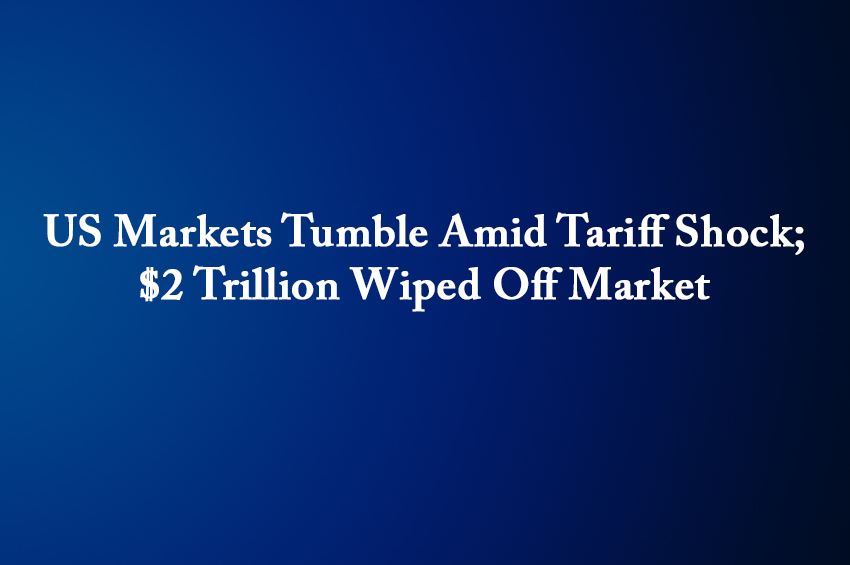Winning Bizness Desk
Mumbai. US stock markets faced a sharp decline on April 3 following the announcement of new reciprocal tariffs by the US administration. The Dow Jones Industrial Average dropped 1,679 points, or 3.98%, closing at 40,545. The S&P 500 slipped 274 points (4.84%) to 5,450, while the tech-heavy Nasdaq Composite registered the steepest fall, plunging 1,050 points (5.97%). This broad-based sell-off led to a major erosion in market value across sectors, from technology and retail to banking and aviation.
Apple, Nike Shares Plunge Up to 15%
Shares of top American companies such as Apple, Nike, Boeing, and Amazon nosedived, with some losing as much as 15% in a single session. The announcement triggered panic selling, particularly in sectors heavily reliant on global supply chains. The apparel, technology, and airline industries were among the worst hit. The decline also extended to online retailers and banks, reflecting widespread investor anxiety over the potential economic fallout of higher tariffs.
$2 Trillion Wiped Out in Market Value
The market capitalization of US stocks saw a sharp erosion of nearly $2 trillion (approx. ₹170 lakh crore) in a single day. According to available data, the total market cap of the S&P 500 stood at $47.681 trillion on April 2, which declined to approximately $45.373 trillion by April 3. Leading the decline in the Dow Jones were stocks like Nike, Boeing, American Express, Dow Inc., and Goldman Sachs.
Why the Tariffs Sparked a Market Meltdown
Three key concerns led to the steep sell-off. First, the fear of lower corporate profits, as the new tariffs would raise the cost of imported goods, increasing production expenses for American companies. With imports from countries like China and Vietnam facing tariffs as high as 34% and 46% respectively, investor sentiment turned sharply negative. Second, the move stoked fears of a global trade war, as affected countries may retaliate by imposing counter-tariffs on US goods. Lastly, concerns over a potential economic slowdown deepened, with crude oil prices falling to $69.63 per barrel, indicating weaker demand and slowing economic activity.
Impact Across Key Sectors
The airline industry, which had projected strong earnings for 2025, may face reduced travel spending if inflation rises due to higher tariffs on essential goods. Footwear and apparel companies, which manufacture much of their products overseas, are bracing for higher import duties. Tech firms, many of which assemble their devices abroad or source critical components internationally, are also exposed. Banks could see reduced lending activity if economic uncertainty escalates, while automakers like Ford and GM remained relatively insulated due to sourcing raw materials domestically.
New Tariffs Effective from April 9
The new tariff structure will be implemented in two phases. A baseline tariff of 10% on all imports will take effect from April 5. A second round, dubbed “reciprocal tariffs,” will be enforced from midnight on April 9. These reciprocal tariffs are being introduced as a direct response to what the US administration sees as unfair duties imposed by other countries on American products.
In a nutshell;
1. Dow Jones plunged 1,679 points, closing at 40,545, down nearly 4%.
2. Nasdaq Composite suffered the steepest fall, down 5.97% or 1,050 points.
3. Market cap of US stocks fell by $2 trillion in a single trading session.
4. Shares of Apple, Nike, Boeing, and Amazon dropped up to 15%.
5. S&P 500 market cap fell from $47.681 trillion to $45.373 trillion in one day.
6. Reciprocal tariffs to be implemented in two phases on April 5 and 9.
7. US to impose a 10% baseline tariff on all imports.
8. Tariffs as high as 34% on China, 46% on Vietnam announced.
9. President Trump justified 26% tariff on India, citing India’s 52% duty on US goods.
10. Fears of global trade war and economic slowdown triggered widespread sell-off.


